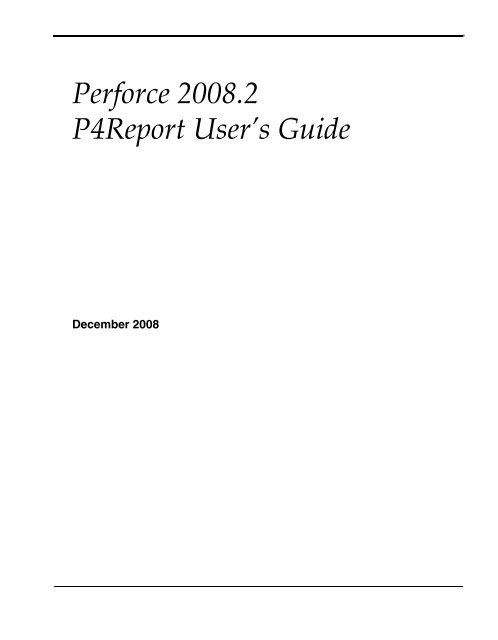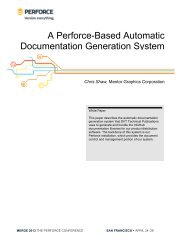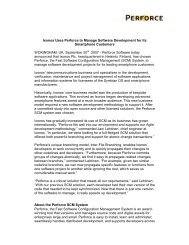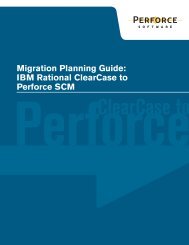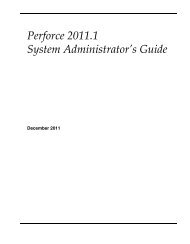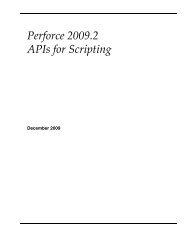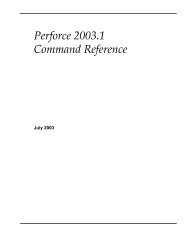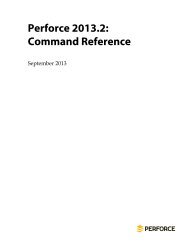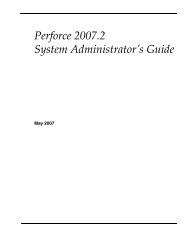You also want an ePaper? Increase the reach of your titles
YUMPU automatically turns print PDFs into web optimized ePapers that Google loves.
<strong>Perforce</strong> <strong>2008.2</strong><br />
<strong>P4Report</strong> User’s <strong>Guide</strong><br />
December 2008
This manual copyright 2002-2008 <strong>Perforce</strong> Software.<br />
All rights reserved.<br />
<strong>Perforce</strong> software and documentation is available from http://www.perforce.com. You may download and use<br />
<strong>Perforce</strong> programs, but you may not sell or redistribute them. You may download, print, copy, edit, and redistribute<br />
the documentation, but you may not sell it, or sell any documentation derived from it. You may not modify or<br />
attempt to reverse engineer the programs.<br />
<strong>Perforce</strong> programs and documents are available from our Web site as is. No warranty or support is provided.<br />
Warranties and support, along with higher capacity servers, are sold by <strong>Perforce</strong> Software.<br />
<strong>Perforce</strong> Software assumes no responsibility or liability for any errors or inaccuracies that may appear in this book.<br />
By downloading and using our programs and documents you agree to these terms.<br />
<strong>Perforce</strong> and Inter-File Branching are trademarks of <strong>Perforce</strong> Software. <strong>Perforce</strong> software includes software<br />
developed by the University of California, Berkeley and its contributors.<br />
Microsoft ®Excel and Microsoft ®Query © Microsoft Corporation; Crystal Reports © Seagate Software. All other<br />
brands or product names are trademarks or registered trademarks of their respective companies or organizations.
Table of Contents<br />
Preface About This Manual....................................................... 7<br />
Please Give Us Feedback ...................................................................................7<br />
Chapter 1 Configuring and Using <strong>P4Report</strong>............................... 9<br />
Configuring an ODBC Data Source .................................................................9<br />
Reporting Using Microsoft Excel ...................................................................10<br />
Creating Queries Using the Query Wizard ..............................................10<br />
Entering SQL Queries in Microsoft Excel .................................................11<br />
Using the <strong>Perforce</strong> SQL Command-Line Client...........................................11<br />
Launching the command line client ..........................................................12<br />
Running queries ...........................................................................................13<br />
The LIKE clause............................................................................................13<br />
Limiting the number of rows returned .....................................................13<br />
ODBC syntax vs. SQL-92 syntax: joins and escape sequences ..............14<br />
Query Performance ..........................................................................................15<br />
Avoid uncorrelated subqueries ..................................................................15<br />
Memory and CPU usage .............................................................................15<br />
Chapter 2 Administrative Reporting.......................................... 17<br />
What users made the most changes?.............................................................17<br />
What has a specified user done in the past 24 hours?.................................17<br />
What clients haven't been used in a year or more? .....................................17<br />
What users haven't been used in a year or more? .......................................17<br />
What clients belong to a specified user? .......................................................17<br />
How many files/which files does a specified user have open? ................17<br />
Which groups contain a specified user?........................................................18<br />
What users have superuser privileges?.........................................................18<br />
<strong>Perforce</strong> <strong>2008.2</strong> <strong>P4Report</strong> User’s <strong>Guide</strong> 3
Table of Contents<br />
Chapter 3<br />
Defect Tracking............................................................19<br />
Overview........................................................................................................... 19<br />
What jobs are unassigned? ............................................................................. 19<br />
What jobs were entered by a specified user?............................................... 19<br />
What jobs of a specified type are open? ....................................................... 19<br />
How many jobs were closed in a specified branch this quarter?.............. 20<br />
A simple Excel pie chart: display open jobs by job type............................ 20<br />
A simple Excel bar chart: bug totals for the last four quarters.................. 22<br />
Chapter 4 Codeline Management ...............................................25<br />
Which binaries in the mainline exceed 10M in size? .................................. 25<br />
Which changelists affect a release?................................................................ 25<br />
How many changes are in this release?........................................................ 25<br />
Which changes are in this release? ................................................................ 25<br />
Which files changed after being branched? ................................................. 26<br />
Is a particular change in a specified branch?............................................... 26<br />
Appendix A Database Schema and SQL Keywords .....................27<br />
<strong>P4Report</strong> System Catalogs.............................................................................. 27<br />
SYSTABS ....................................................................................................... 27<br />
SYSTYPES..................................................................................................... 27<br />
SYSCOLS....................................................................................................... 29<br />
SYSIDXS........................................................................................................ 30<br />
<strong>P4Report</strong> Tables................................................................................................ 30<br />
BRANCHES.................................................................................................. 30<br />
CHANGES.................................................................................................... 30<br />
CLIENTS....................................................................................................... 31<br />
COUNTERS.................................................................................................. 32<br />
FILES ............................................................................................................. 32<br />
FIXES ............................................................................................................. 33<br />
FSTAT ............................................................................................................ 34<br />
GROUPS ....................................................................................................... 35<br />
INFO.............................................................................................................. 36<br />
INTEGS ......................................................................................................... 36<br />
JOBS............................................................................................................... 37<br />
LABELS......................................................................................................... 38<br />
4 <strong>Perforce</strong> <strong>2008.2</strong> <strong>P4Report</strong> User’s <strong>Guide</strong>
Table of Contents<br />
OPENED........................................................................................................38<br />
PROTECTIONS ............................................................................................39<br />
RESOLVED....................................................................................................39<br />
USERS ............................................................................................................40<br />
SQL Keywords ..................................................................................................41<br />
Appendix B <strong>P4Report</strong> Functions..................................................... 43<br />
Connection Information Functions ................................................................43<br />
String Functions................................................................................................43<br />
Numeric Functions...........................................................................................45<br />
Date and Time Functions.................................................................................46<br />
Appendix C Sample Crystal Report Queries................................. 49<br />
Index ............................................................................. 51<br />
<strong>Perforce</strong> <strong>2008.2</strong> <strong>P4Report</strong> User’s <strong>Guide</strong> 5
Table of Contents<br />
6 <strong>Perforce</strong> <strong>2008.2</strong> <strong>P4Report</strong> User’s <strong>Guide</strong>
Preface<br />
About This Manual<br />
This manual describes the <strong>Perforce</strong> Reporting System (<strong>P4Report</strong>), which enables you to<br />
create reports by accessing the database where <strong>Perforce</strong> stores information about the files,<br />
users, clients, and jobs in its control. To access the database, you use SQL with an ODBC<br />
driver. Microsoft defines ODBC as follows:<br />
“Open Database Connectivity (ODBC) is a widely accepted application<br />
programming interface (API) for database access. It is based on the<br />
Call-Level Interface (CLI) specifications from X/Open and ISO/IEC for<br />
database APIs and uses Structured Query Language (SQL) as its database<br />
access language.”<br />
After you install <strong>P4Report</strong>, you can use tools such as Microsoft Excel or Crystal Reports<br />
(or any tool that can interact with an ODBC data source) to report on <strong>Perforce</strong> activity. This<br />
guide provides examples of typical queries and reports.<br />
<strong>P4Report</strong> includes the <strong>Perforce</strong> SQL Command-Line Client (P4SQL), which enables you to<br />
test queries against your <strong>Perforce</strong> server before embedding the queries into a reporting<br />
tool. To use the tool, choose Start><strong>Perforce</strong> SQL>SQL Command Line Client. <strong>P4Report</strong><br />
launches P4SQL in a DOS window. At the SQL prompt, you can issue valid SQL-92 queries.<br />
For details about using the command line client, refer to “Using the <strong>Perforce</strong> SQL<br />
Command-Line Client” on page 11.<br />
For details about the SQL functions supported by <strong>P4Report</strong>, refer to Appendix B, <strong>P4Report</strong><br />
Functions. For details about the schema of the <strong>Perforce</strong> database, refer to Appendix A,<br />
Database Schema and SQL Keywords.<br />
Please Give Us Feedback<br />
Does this guide provide the information you need to succeed with the product? Email<br />
comments and questions to manual@perforce.com.<br />
<strong>Perforce</strong> <strong>2008.2</strong> <strong>P4Report</strong> User’s <strong>Guide</strong> 7
Preface: About This Manual<br />
8 <strong>Perforce</strong> <strong>2008.2</strong> <strong>P4Report</strong> User’s <strong>Guide</strong>
Chapter 1<br />
Configuring and Using<br />
<strong>P4Report</strong><br />
To install <strong>P4Report</strong>, download the installer from the <strong>Perforce</strong> web site and run it. The<br />
installer enables you to specify where you want <strong>P4Report</strong> installed and to choose from<br />
available options. When you install <strong>P4Report</strong>, the installation program configures a<br />
default ODBC data source using the <strong>Perforce</strong> settings in effect on your client computer. To<br />
access other <strong>Perforce</strong> servers, you can modify the default data source or configure<br />
additional ODBC data sources, one for each server. The following section tells you how.<br />
Configuring an ODBC Data Source<br />
To configure an ODBC data source for a specific <strong>Perforce</strong> server, perform the following<br />
steps:<br />
1. Choose Start><strong>Perforce</strong>><strong>P4Report</strong>>Data Sources.<br />
The ODBC Data Source Administrator dialog is displayed.<br />
2. Click Add... The Create New Data Source dialog is displayed.<br />
3. Scroll to <strong>Perforce</strong> ODBC Driver, click it, then click Finish. The ODBC <strong>P4Report</strong><br />
Setup dialog is displayed.<br />
4. Enter the required information as follows:<br />
• Data Source Name: assign a name that corresponds to the <strong>Perforce</strong> server from<br />
which you intend to retrieve data. (The Description field is optional.)<br />
• Port: the host computer and TCP/IP port number on which the <strong>Perforce</strong> server listens<br />
for client requests. Corresponds to the <strong>Perforce</strong> P4PORT setting.<br />
• User: the name of the <strong>Perforce</strong> user that <strong>P4Report</strong> uses to connect to the <strong>Perforce</strong><br />
server. Corresponds to the <strong>Perforce</strong> P4USER setting.<br />
• Client: the name of the <strong>Perforce</strong> client specification that <strong>P4Report</strong> uses to connect to<br />
the <strong>Perforce</strong> server. Corresponds to the <strong>Perforce</strong> P4CLIENT setting.<br />
• Host: the name of the <strong>Perforce</strong> client computer. Corresponds to the <strong>Perforce</strong> P4HOST<br />
setting.<br />
• Charset: set the field only if your server is running in Unicode mode. Default is<br />
P4CHARSET. For details about Unicode-mode servers, refer to the <strong>Perforce</strong> System<br />
Administrators <strong>Guide</strong>.<br />
<strong>Perforce</strong> <strong>2008.2</strong> <strong>P4Report</strong> User’s <strong>Guide</strong> 9
Chapter 1: Configuring and Using <strong>P4Report</strong><br />
• To configure the data source to use the <strong>Perforce</strong> settings in effect on the client<br />
computer at run time (instead of specifying fixed settings), check the Default boxes<br />
for the desired settings. For details about <strong>Perforce</strong> settings, refer to Introducing<br />
<strong>Perforce</strong>.<br />
• To configure the data source so that ODBC client programs can update the<br />
underlying data, check the Enable Updates box.<br />
5. Click OK. Your data source is added to the list of data sources displayed on the<br />
ODBC Data Source Administrator dialog.<br />
Reporting Using Microsoft Excel<br />
To create reports based on <strong>Perforce</strong> data, you can use any reporting tool that accepts data<br />
from an ODBC data source. This guide tells you how to create reports using Microsoft<br />
Excel.<br />
Before you define queries in Excel, be sure to define all required data sources as described<br />
in the preceding section, “Configuring an ODBC Data Source” on page 9.<br />
To enter the SQL queries in the guide into Microsoft Excel spreadsheets, you must have<br />
Microsoft Query installed. There are two ways you can query the <strong>Perforce</strong> database:<br />
• Query Wizard: the Query Wizard enables you to define simple queries graphically.<br />
• SQL: For complex queries, such as queries that use SQL functions that are not available<br />
in the Query Wizard, you can enter SQL. You can use the SQL queries in this guide as<br />
templates.<br />
Creating Queries Using the Query Wizard<br />
To create queries using the Query Wizard, perform the following steps.<br />
1. Launch Excel. A new, empty spreadsheet is displayed.<br />
2. Choose Data>Get External Data>New Database Query... The Choose Data Source<br />
dialog is displayed.<br />
3. On the Databases tab, choose the <strong>Perforce</strong> data source from the list of data sources<br />
and click OK. The Query Wizard - Choose Columns dialog is displayed.<br />
4. Expand the desired tables, choose the desired columns column, and click > to move<br />
the columns into the Columns in your query list.<br />
5. Click Next. The Filter Data dialog is displayed.<br />
6. Enter any conditions you want to apply to the data, to extract only the data on which<br />
you want to report.<br />
10 <strong>Perforce</strong> <strong>2008.2</strong> <strong>P4Report</strong> User’s <strong>Guide</strong>
Chapter 1: Configuring and Using <strong>P4Report</strong><br />
7. Click Next. The Sort Data dialog is displayed.<br />
8. Specify any sort orders you want to apply to the data. For example, to display time or<br />
date fields starting with the most recent, sort these fields in descending order.<br />
9. Click Next. The Finish dialog is displayed. Click Finish to return the data to your<br />
spreadsheet.<br />
Entering SQL Queries in Microsoft Excel<br />
To enter an SQL query into a spreadsheet, perform the following steps.<br />
1. Launch Excel. A new, empty spreadsheet is displayed.<br />
2. Choose Data>Get External Data>New Database Query... The Choose Data Source<br />
dialog is displayed.<br />
3. On the Databases tab, choose the <strong>Perforce</strong> data source from the list of data sources<br />
and click OK. The Query Wizard - Choose Columns dialog is displayed.<br />
4. Expand any table, choose any one column, and click > to move the column into the<br />
Columns in your query list. It does not matter which column you choose, because<br />
you will replace the entire query with your own.<br />
5. Click Next. The Filter Data dialog is displayed.<br />
6. Click Next. The Sort Data dialog is displayed.<br />
7. Click Next. The Finish Dialog is displayed.<br />
8. Choose the View or edit data in Microsoft Query option and click Finish. Microsoft<br />
Query is launched, displaying your initial query.<br />
9. Choose View>SQL... The SQL dialog is displayed.<br />
10. Enter your SQL query in the SQL window and click OK. If your SQL query is correctly<br />
formed and the <strong>Perforce</strong> database contains any data that fulfills the query conditions,<br />
Microsoft Query displays the data in its main window.<br />
11. To place the data in your spreadsheet, choose File>Return Data to Microsoft Excel.<br />
Using the <strong>Perforce</strong> SQL Command-Line Client<br />
P4SQL, the <strong>Perforce</strong> SQL Command-Line Client, enables you to query <strong>Perforce</strong> servers<br />
directly using SQL, without going through Microsoft Excel, Crystal Reports, or other<br />
reporting software. P4SQL runs in a DOS window and accepts SQL-92-compliant queries.<br />
By default P4SQL queries the server specified by the <strong>Perforce</strong> settings in effect on your<br />
client computer (P4PORT, P4USER, P4CLIENT, and P4HOST) and does not use an ODBC data<br />
source. To specify an ODBC data source, use the -n flag when you invoke P4SQL.<br />
<strong>Perforce</strong> <strong>2008.2</strong> <strong>P4Report</strong> User’s <strong>Guide</strong> 11
Chapter 1: Configuring and Using <strong>P4Report</strong><br />
Launching the command line client<br />
To launch P4SQL, choose <strong>Perforce</strong>><strong>P4Report</strong>>SQL Command-Line Client. A DOS<br />
window is launched and the command line client is started. Alternately, open a DOS<br />
window, change to the directory where you installed <strong>P4Report</strong>, and run p4sql from the<br />
command line. When invoked from the command line, the SQL command line client<br />
accepts the following flags:<br />
Flag<br />
Description<br />
-c client Set client name (default P4CLIENT)<br />
-C charset Specify character set, only if querying a Unicode-mode<br />
server. Default is P4CHARSET. For details about Unicodemode<br />
servers, refer to the <strong>Perforce</strong> System Administrators<br />
<strong>Guide</strong>.<br />
-d "delimiters" Specify the column delimiter characters for output. You can<br />
specify a single delimiter character or a string (multiple<br />
characters). If the delimiter character has meaning to the<br />
command shell, enclose it in double quotes.<br />
For example, to put a comma between column values, invoke<br />
P4SQL AS follows:<br />
p4sql -d ","<br />
-e Enable updates and inserts.<br />
-H host Set host name (default P4HOST)<br />
-h or -? Print usage message<br />
-i file Execute the SQL queries in the specified text file.<br />
-n ODBC_data_source Specify an ODBC data source to query<br />
-P password Set user's password (default P4PASSWD)<br />
-p port Set server port (default P4PORT).<br />
-q Set quiet mode (suppresses header/footer output)<br />
-s query Run a single SQL statement. For example:<br />
p4sql -s "select * from jobs"<br />
-u user Set user’s <strong>Perforce</strong> username (default P4USER)<br />
-V Print version information<br />
12 <strong>Perforce</strong> <strong>2008.2</strong> <strong>P4Report</strong> User’s <strong>Guide</strong>
Chapter 1: Configuring and Using <strong>P4Report</strong><br />
Running queries<br />
At the SQL> prompt, enter your queries (for example, select * from users;). By default<br />
you cannot alter the <strong>Perforce</strong> metadata using <strong>P4Report</strong>. To enable updating, start P4SQL<br />
from the command line, specifying the -e flag (or add the -e flag to the command<br />
associated with the SQL Command Line Client menu shortcut).<br />
Note that typing RETURN or ENTER does not submit your query. You must terminate<br />
every query with a semicolon (;).<br />
You can create text files that contain queries and run them from the command line by<br />
invoking the command line client, specifying the -i flag. You can send query output to an<br />
output file. By default, the query output returned by P4SQL is tab-delimited, enabling you<br />
to import it into Microsoft Excel. For example, to store query output in a file named<br />
output.txt, invoke P4SQL as follows:<br />
C:\Program Files\<strong>Perforce</strong>\p4sql.exe -i query.txt > output.txt<br />
The LIKE clause<br />
In <strong>P4Report</strong> queries, LIKE clauses are case-sensitive so they can be sent verbatim to a<br />
UNIX <strong>Perforce</strong> server.<br />
The SQL wildcards _ and %, which match single and multiple characters respectively, are<br />
translated by <strong>P4Report</strong> into <strong>Perforce</strong> wildcards as follows:<br />
SQL wildcard <strong>Perforce</strong> wildcard<br />
% ...<br />
_ *<br />
Limiting the number of rows returned<br />
To ensure that a query returns no more than a specified maximum number of rows,<br />
include the LIMIT clause in the query. For example, the following query returns no more<br />
than 40 rows:<br />
p4sql -s "select depotFile from fstat<br />
where filespec='//depot/main/server/....cc' limit 40<br />
You can also specify the start row using the LIMIT clause. For example, if you want your<br />
query to return 40 rows starting with the fifth row, discarding the first four result rows,<br />
specify an offset of five as follows:<br />
p4sql -s "select depotFile from fstat<br />
where filespec='//depot/main/server/....cc' limit 5, 40<br />
The syntax for the LIMIT clause is as follows:<br />
LIMIT [,]<br />
<strong>Perforce</strong> <strong>2008.2</strong> <strong>P4Report</strong> User’s <strong>Guide</strong> 13
Chapter 1: Configuring and Using <strong>P4Report</strong><br />
ODBC syntax vs. SQL-92 syntax: joins and escape sequences<br />
Join syntax<br />
The SQL-92 syntax for expressing joins is as follows (words in square brackets [] are<br />
optional):<br />
SELECT * FROM table-reference [NATURAL] JOIN table-reference<br />
where is one of the following:<br />
• INNER<br />
• LEFT [OUTER]<br />
• RIGHT [OUTER]<br />
• FULL [OUTER]<br />
• UNION<br />
• CROSS<br />
The ODBC standard defines its own outer join syntax, as follows:<br />
SELECT * from {oj table-reference {LEFT | RIGHT | FULL}<br />
OUTER JOIN {table-reference}<br />
<strong>P4Report</strong> supports the ODBC join syntax, but the syntax is primarily designed for ODBC<br />
applications that generate queries and require a standard way of specifying outer join<br />
queries. For purposes of simplicity, SQL-92 join syntax is recommended.<br />
Escape sequences<br />
Curly brackets ({}) are used by ODBC for escape sequences that contain standard syntaxes<br />
for the following SQL features:<br />
• Date, time, timestamp, and datetime interval literals<br />
• Scalar functions such as numeric, string, and data type conversion functions<br />
• LIKE predicate escape character<br />
• Procedure calls<br />
•Outer joins<br />
Note that <strong>P4Report</strong> discards ODBC escape sequences when parsing an SQL expression,<br />
thereby converting the expression into a standard SQL one. If you use the preceding<br />
features, use standard SQL syntax and do not use ODBC escape sequences.<br />
14 <strong>Perforce</strong> <strong>2008.2</strong> <strong>P4Report</strong> User’s <strong>Guide</strong>
Chapter 1: Configuring and Using <strong>P4Report</strong><br />
Query Performance<br />
Avoid uncorrelated subqueries<br />
For best performance, avoid queries that contain uncorrelated subqueries, because the<br />
subquery is executed for every row returned by the SELECT clause. Instead of subselects,<br />
use joins.<br />
For example, instead of this subselect:.<br />
select user from users where user in (select owner from clients);<br />
use a simple join:.<br />
select user from users, clients where user = owner;<br />
Memory and CPU usage<br />
Queries that contain an ORDER BY or GROUP BY clause require <strong>P4Report</strong> to load the report<br />
set into memory for sorting. For such queries, memory use increases in proportion to the<br />
number of rows in the result set, the number of columns in each row and the size of each<br />
column.<br />
When a query is running, the SQL engine processes data until the query is complete. To<br />
process the data as fast as possible, the engine uses all the CPU time that it is given. If you<br />
monitor query performance, you are likely to see high CPU consumption during query<br />
processing.<br />
<strong>Perforce</strong> <strong>2008.2</strong> <strong>P4Report</strong> User’s <strong>Guide</strong> 15
Chapter 1: Configuring and Using <strong>P4Report</strong><br />
16 <strong>Perforce</strong> <strong>2008.2</strong> <strong>P4Report</strong> User’s <strong>Guide</strong>
Chapter 2<br />
Administrative Reporting<br />
This chapter contains queries that return information about <strong>Perforce</strong> clients and users,<br />
typically of interest to system administrators. You can use these queries in Microsoft<br />
Excel, Crystal Reports, and other tools that can be configured with ODBC data sources. For<br />
details about executing SQL queries in Excel, see “Reporting Using Microsoft Excel” on<br />
page 10. For details about supported functions, refer to Appendix B, <strong>P4Report</strong> Functions.<br />
What users made the most changes?<br />
select user, count(*) from changes<br />
group by user<br />
order by 2 desc;<br />
What has a specified user done in the past 24 hours?<br />
select change, description from changes<br />
where user='jones' and timestampdiff(3, date, curtime()) < 24;<br />
What clients haven't been used in a year or more?<br />
select client, owner, accessed from clients<br />
where timestampdiff(8, accessed, curtimestamp())>0;<br />
What users haven't been used in a year or more?<br />
select user, fullname, accessed from users<br />
where timestampdiff(8, accessed, curtimestamp())>0;<br />
What clients belong to a specified user?<br />
select client, owner, accessed from clients<br />
where owner='jones';<br />
How many files/which files does a specified user have<br />
open?<br />
select client, count(*) from opened<br />
group by client<br />
order by 2 desc;<br />
<strong>Perforce</strong> <strong>2008.2</strong> <strong>P4Report</strong> User’s <strong>Guide</strong> 17
Chapter 2: Administrative Reporting<br />
Which groups contain a specified user?<br />
select groupname from groups<br />
where userspec='tonyz';<br />
What users have superuser privileges?<br />
select * from protections<br />
where mode = 'super' and type = 'user';<br />
Note<br />
The results of queries against the protections table can be misleading.<br />
Identifying paths in the protection table that have a specified access level<br />
is not the same as determining the access level for that path. <strong>P4Report</strong> can<br />
report on records in the protections table that match an evaluation<br />
condition (user, path, access), but <strong>P4Report</strong> cannot actually compute the<br />
protections. Computing protections requires knowledge of the order of<br />
the protection lines, exclusionary mappings, and <strong>Perforce</strong> wildcards.<br />
18 <strong>Perforce</strong> <strong>2008.2</strong> <strong>P4Report</strong> User’s <strong>Guide</strong>
Chapter 3<br />
Defect Tracking<br />
Overview<br />
You can change the structure of <strong>Perforce</strong> jobs by altering the job specification (see the<br />
<strong>Perforce</strong> System Administrator’s <strong>Guide</strong> for details). The queries in this chapter are based on a<br />
job specification containing the following fields:<br />
dependency<br />
description<br />
job<br />
modifiedby<br />
modifieddate<br />
ownedby<br />
priority<br />
release<br />
reportedby<br />
reporteddate<br />
severity<br />
status<br />
subsystem<br />
type<br />
You cannot create a query or report on one server and then execute it against a server<br />
which has a different job specification. If you change the job specification, you might need<br />
to change the corresponding <strong>P4Report</strong> queries, especially if you rename or remove fields.<br />
Note that job status can be easily changed, and a job can be reopened after being closed.<br />
The examples in this section assume that the defect tracking process does not allow jobs to<br />
be reopened.<br />
For details about supported SQL functions, refer to Appendix B, <strong>P4Report</strong> Functions.<br />
What jobs are unassigned?<br />
select job from jobs<br />
where ownedby = '' and status='open';<br />
What jobs were entered by a specified user?<br />
select * from jobs<br />
where reportedby = 'tonyz' and status='open';<br />
What jobs of a specified type are open?<br />
select * from jobs<br />
where type = 'bug' and status = 'open';<br />
<strong>Perforce</strong> <strong>2008.2</strong> <strong>P4Report</strong> User’s <strong>Guide</strong> 19
Chapter 3: Defect Tracking<br />
How many jobs were closed in a specified branch this<br />
quarter?<br />
select count(job) from jobs<br />
where filespec='//depot/main/release1.1...'<br />
and status='closed'<br />
and quarter(modifieddate)=quarter(curdate());<br />
A simple Excel pie chart: display open jobs by job type<br />
You can create an Excel pie chart that displays the percentage of total open jobs assigned<br />
to each component you track using <strong>Perforce</strong>. Note that the <strong>Perforce</strong> job specification can<br />
be customized. This example assumes that your job specification includes a “status” field<br />
and a “subsystem” field.<br />
To load the data, perform the following steps:<br />
1. Launch Excel. An empty spreadsheet is displayed.<br />
2. Choose Data>Get External Data>New Database Query... The Choose Data Source<br />
dialog is displayed.<br />
3. On the Databases tab, choose the <strong>Perforce</strong> data source from the list of data sources<br />
and click OK. The Query Wizard - Choose Columns dialog is displayed.<br />
4. Expand the jobs table and move the status and subsystem columns into the<br />
Columns in your query list.<br />
5. Click Next. The Filter Data dialog is displayed.<br />
6. Click the status field. In the Only include rows where group, choose equals from the<br />
left drop-down list of conditions, and enter “open” in the field on the right.<br />
7. Click Next. The Sort Data dialog is displayed.<br />
8. From the drop-down list, choose “subsystem” and click Next. The Finish dialog is<br />
displayed. Click Finish to return the data to your spreadsheet.<br />
9. On your spreadsheet, Excel displays the Returning External Data to Microsoft Excel<br />
dialog. Specify where you want the data placed and click OK. Two columns of data<br />
are loaded into your spreadsheet.<br />
To create the chart from the data you loaded, perform the following steps:<br />
1. Select the data by clicking the buttons at the top of the columns. (For example, if you<br />
loaded data starting at the top right cell, click the A and B buttons.)<br />
2. Choose Data>PivotTable and PivotChart Report. The PivotTable and PivotChart<br />
wizard is launched and displays the Step 1 of 3 dialog.<br />
20 <strong>Perforce</strong> <strong>2008.2</strong> <strong>P4Report</strong> User’s <strong>Guide</strong>
Chapter 3: Defect Tracking<br />
3. Select the Microsoft Excel list or database and PivotTable options and click Next.<br />
The Step 2 of 3 dialog is displayed, listing the range of data in the selected columns.<br />
4. Click Next. The Step 3 of 3 dialog is displayed, asking where you want to put the<br />
chart.<br />
5. Choose New worksheet and click Finish. Excel display the PivotTable designer.<br />
6. Drag the status field, followed by the subsystem field, from the pallet to the report<br />
heading fields as shown in the following figure.<br />
Excel displays a table showing your data summarized by subsystem.<br />
7. Right-click the summarized list and choose PivotChart from the context menu. Excel<br />
displays a bar chart of your data.<br />
8. To change the chart type, right-click the chart and choose Chart Type... from the<br />
context menu. To display a pie chart, choose Pie from the Standard Types tab and<br />
specify your preferred display options.<br />
<strong>Perforce</strong> <strong>2008.2</strong> <strong>P4Report</strong> User’s <strong>Guide</strong> 21
Chapter 3: Defect Tracking<br />
A simple Excel bar chart: bug totals for the last four<br />
quarters<br />
This chart displays the number of bugs opened in the each of the last four quarters. To<br />
create the chart, perform the following steps:<br />
1. Launch Excel. A new, empty spreadsheet is displayed.<br />
2. Choose Data>Get External Data>New Database Query... The Choose Data Source<br />
dialog is displayed.<br />
3. On the Databases tab, choose the <strong>Perforce</strong> data source from the list of data sources<br />
and click OK. The Query Wizard - Choose Columns dialog is displayed.<br />
4. Expand any table, choose any one column, and click > to move the column into the<br />
Columns in your query list. It does not matter which column you choose, because<br />
you will replace the entire query with your own SQL.<br />
5. Click Next. The Filter Data dialog is displayed.<br />
6. Click Next. The Sort Data dialog is displayed.<br />
7. Click Next. The Finish Dialog is displayed.<br />
8. Choose the View or edit data in Microsoft Query option and click Finish. Microsoft<br />
Query is launched, displaying your initial query.<br />
9. Choose View>SQL... The SQL dialog is displayed.<br />
10. Enter the following SQL query in the SQL window and click OK:<br />
select jobs.job,<br />
concat(concat(year(reporteddate), ' '),<br />
concat('q',quarter(reporteddate))) from jobs jobs<br />
where (jobs.type='bug')<br />
and timestampdiff(7,reporteddate,curtimestamp())Return Data to Microsoft Excel. The data is returned to your<br />
spreadsheet.<br />
22 <strong>Perforce</strong> <strong>2008.2</strong> <strong>P4Report</strong> User’s <strong>Guide</strong>
Chapter 3: Defect Tracking<br />
To format the bar chart, perform the following steps:<br />
1. Select the data: click the top right cell where the data starts, scroll to the bottom left<br />
cell and shift-click it. Excel highlights the cells you selected.<br />
2. Choose Data>PivotTable and PivotChart Report. The PivotTable and PivotChart<br />
wizard is launched and displays the Step 1 of 3 dialog.<br />
3. Select the Microsoft Excel list or database and PivotTable options and click Next.<br />
The Step 2 of 3 dialog is displayed, listing the range of data in the selected columns.<br />
4. Click Next. The Step 3 of 3 dialog is displayed, asking where you want to put the<br />
chart.<br />
5. Choose New worksheet and click Finish. Excel displays the PivotTable designer.<br />
6. Drag the job field, followed by the expr field, from the pallet to the report heading<br />
fields as shown in the following figure.<br />
Excel displays a table showing your data summarized by subsystem.<br />
<strong>Perforce</strong> <strong>2008.2</strong> <strong>P4Report</strong> User’s <strong>Guide</strong> 23
Chapter 3: Defect Tracking<br />
7. Right-click the summarized list and choose PivotChart from the context menu. Excel<br />
displays a bar chart of your data, such as the example in the following figure.<br />
24 <strong>Perforce</strong> <strong>2008.2</strong> <strong>P4Report</strong> User’s <strong>Guide</strong>
Chapter 4<br />
Codeline Management<br />
For details about supported functions, refer to Appendix B, <strong>P4Report</strong> Functions.<br />
Which binaries in the mainline exceed 10M in size?<br />
select fileSize,depotFile,headType,headTime from fstat<br />
where filespec = '//depot/main/p4-bin/...'<br />
and fileSize > 10000000<br />
order by 1 asc<br />
Which changelists affect a release?<br />
To list changes without including integrations:<br />
select change from changes<br />
where filespec = '//depot/main/release2.0/...';<br />
To list changes including integrations, include the options='integrated' clause:<br />
select change from changes<br />
where filespec = '//depot/main/release2.0/...'<br />
and p4options = 'integrated';<br />
How many changes are in this release?<br />
If the release is a branch:<br />
select count(*) from changes<br />
where filespec = '//depot/release1.1/...';<br />
If the release is stored in a label:<br />
select count(*) from changes<br />
where filespec = '//...@release1.1';<br />
Which changes are in this release?<br />
If the release is a branch:<br />
select * from changes<br />
where filespec = '//depot/release1.1/...';<br />
If the release is stored in a label:<br />
select * from changes<br />
where filespec = '//...@release1.1';<br />
<strong>Perforce</strong> <strong>2008.2</strong> <strong>P4Report</strong> User’s <strong>Guide</strong> 25
Chapter 4: Codeline Management<br />
Which files changed after being branched?<br />
When you integrate files to a new branch, the files in the new branch have a revision<br />
number of 1. This query detects files with higher revision numbers by seeking files that<br />
have more than more record in the FILES table. Using this logic, the following query<br />
detects all changed files in //depot/branch1/... :<br />
select file, count(*) from files<br />
where file like '//depot/branch1/%' group<br />
by file having count(*) > 1;<br />
Is a particular change in a specified branch?<br />
The answer returned by this query is independent of whether the change was made in a<br />
specified branch or integrated from another branch.<br />
select fromfile, endfromrev from files, integs<br />
where change = 123 and<br />
file = tofile and<br />
how in ('copy into', 'merge into', 'branch into', 'delete into') and<br />
fromfile like '//depot/branch1/%' and<br />
revision between starttorev and endtorev<br />
union<br />
select file, revision from files<br />
where change = 123 and<br />
file like '//depot/branch1/%';<br />
26 <strong>Perforce</strong> <strong>2008.2</strong> <strong>P4Report</strong> User’s <strong>Guide</strong>
Appendix A Database Schema and SQL<br />
Keywords<br />
<strong>P4Report</strong> includes an ODBC driver that renders a subset of the information in the <strong>Perforce</strong><br />
database as a set of tables. This chapter describes the SQL data types of the data returned<br />
by <strong>P4Report</strong>. You can use the information in this chapter to create SQL queries. Note that<br />
the <strong>P4Report</strong> engine adds some virtual columns for query purposes; these columns are<br />
not physically present in the <strong>Perforce</strong> metadata.<br />
This chapter also includes a list of SQL keywords reserved by <strong>P4Report</strong>.<br />
<strong>P4Report</strong> System Catalogs<br />
The system catalogs are tables that contain data describing the <strong>Perforce</strong> metadata tables.<br />
SYSTABS<br />
Lists all tables<br />
Column Name Data Type Description<br />
CATALOG CHAR(32) The name of the catalog in which the table<br />
resides (system or perforce).<br />
TABNAME CHAR(32) The name of the table.<br />
SYSTYPES<br />
Lists all mapped types. This system catalog is included for completeness. The information<br />
stored in the SYSTYPES table is not of general utility for creating <strong>Perforce</strong>-related reports.<br />
Column Name Data Type Description<br />
TYPE_NAME CHAR(32) Name of the data type.<br />
DATA_TYPE SMALLINT Corresponding ODBC or driver-specific SQL<br />
data type.<br />
<strong>Perforce</strong> <strong>2008.2</strong> <strong>P4Report</strong> User’s <strong>Guide</strong> 27
Appendix A: Database Schema and SQL Keywords<br />
Column Name Data Type Description<br />
COLUMN_SIZE INTEGER • Numeric data types: the maximum precision.<br />
• String data types: the length in characters.<br />
• Datetime data types: the length of the<br />
string representation.<br />
• Interval data types: the number of characters<br />
in the character representation of the<br />
interval.<br />
NULL for data types for which column size is<br />
not applicable.<br />
LITERAL_PREFIX CHAR(5) The characters that precede a literal:<br />
• Character data: a single quotation mark (')<br />
• Binary data types: 0x<br />
NULL for data types that have no prefix.<br />
LITERAL_SUFFIX CHAR(5) The characters that follow a literal:<br />
• Character data: a single quotation mark (')<br />
NULL for data types that have no suffix.<br />
CREATE_PARAMS CHAR(32) Lists the parameters that can be specified for<br />
each data type.<br />
NULLABLE SMALLINT Indicates whether the data type accepts a<br />
NULL value.<br />
CASE_SENSITIVE SMALLINT Indicates whether a character data type is<br />
case-sensitive.<br />
SEARCHABLE SMALLINT Specifies how the data type is used in a<br />
WHERE clause.<br />
UNSIGNED_ATTRIBUTE SMALLINT Indicates whether the data type is unsigned.<br />
FIXED_PREC_SCALE SMALLINT Indicates whether the data type has<br />
predefined fixed precision and scale.<br />
AUTO_UNIQUE_VALUE SMALLINT Indicates whether the data type is<br />
autoincrementing.<br />
LOCAL_TYPE_NAME CHAR(32) Specifies the localized data sourcedependent<br />
name of the data type.<br />
28 <strong>Perforce</strong> <strong>2008.2</strong> <strong>P4Report</strong> User’s <strong>Guide</strong>
Appendix A: Database Schema and SQL Keywords<br />
Column Name Data Type Description<br />
MINIMUM_SCALE SMALLINT The minimum scale of the data type. For<br />
example, an SQL_TYPE_TIMESTAMP column<br />
might have a fixed scale for fractional<br />
seconds.<br />
MAXIMUM_SCALE SMALLINT The maximum scale of the data type.<br />
SQL_DATA_TYPE SMALLINT The SQL data type as it appears in the<br />
SQL_DESC_TYPE field of the descriptor.<br />
SQL_DATETIME_SUB SMALLINT For SQL_DATETIME or SQL_INTERVAL, the<br />
datetime/interval subcode.<br />
NUM_PREC_RADIX INTEGER • Approximate numeric types: contains 2 to<br />
indicate that COLUMN_SIZE specifies a<br />
number of bits.<br />
• Exact numeric types: contains the value 10<br />
to indicate that COLUMN_SIZE specifies a<br />
number of decimal digits.<br />
Otherwise, this column is NULL.<br />
INTERVAL_PRECISION SMALLINT For interval data types, contains the value of<br />
the interval leading precision.<br />
SYSCOLS<br />
Lists all columns of all tables<br />
Column Name Data Type Description<br />
CATALOG CHAR(32) The name of the catalog in which the table<br />
resides (system or perforce).<br />
TABNAME CHAR(32) The name of the table.<br />
COLNAME CHAR(32) The name of the column within the table.<br />
COLNO SMALLINT The number of the column within the table,<br />
starting with 1.<br />
COLTYPE SQLTYPE The data type of the column.<br />
<strong>Perforce</strong> <strong>2008.2</strong> <strong>P4Report</strong> User’s <strong>Guide</strong> 29
Appendix A: Database Schema and SQL Keywords<br />
SYSIDXS<br />
Lists the primary key for each table.<br />
Column Name Data Type Description<br />
CATALOG CHAR(32) The name of the catalog in which the table<br />
resides (system or perforce).<br />
TABNAME CHAR(32) The name of the table.<br />
KEYNAME CHAR(32) The name of the key.<br />
COLNAME CHAR(32) The name of the column that forms this part<br />
of the key.<br />
COLNO SMALLINT The position of this column within the key,<br />
starting with 1.<br />
<strong>P4Report</strong> Tables<br />
BRANCHES<br />
Contains a row for each branch specification.<br />
Column Name Data Type Description<br />
BRANCH VARCHAR(254) Name of branch<br />
OWNER VARCHAR(254) The <strong>Perforce</strong> user that created this branch.<br />
P4OPTIONS VARCHAR(254) Branch update options: locked or unlocked.<br />
UPDATED TIMESTAMP The date this specification was last modified<br />
ACCESSED TIMESTAMP The date of the last integration performed<br />
using this branch.<br />
DESCRIPTION LONGVARCHAR A short description of the branch (optional).<br />
CHANGES<br />
Contains a row for each changelist. This table cannot be updated using <strong>P4Report</strong>.<br />
Column Name Data Type Description<br />
CHANGE INTEGER Changelist number.<br />
DATE TIMESTAMP Date the changelist was created.<br />
USER VARCHAR(254) <strong>Perforce</strong> user that created the changelist.<br />
CLIENT VARCHAR(254) <strong>Perforce</strong> client that created the changelist.<br />
STATUS VARCHAR(15) pending or submitted<br />
30 <strong>Perforce</strong> <strong>2008.2</strong> <strong>P4Report</strong> User’s <strong>Guide</strong>
Appendix A: Database Schema and SQL Keywords<br />
Column Name Data Type Description<br />
DESCRIPTION LONGVARCHAR User-specified description of the changelist.<br />
P4OPTIONS VARCHAR(254) Specifies query options. If you specify<br />
multiple options, separate them with spaces,<br />
commas, semicolons or colons. Valid values<br />
are:<br />
• integrated: include any changes integrated<br />
into the specified files. Valid only<br />
in conjunction with the FILESPEC column.<br />
Must be specified in lower case. For example:<br />
SELECT * FROM CHANGES WHERE FILESPEC<br />
= '//depot/main/release2.0/...'<br />
AND P4OPTIONS = 'integrated';<br />
• longdesc: By default, the 31-character<br />
short description is returned, to ensure<br />
best query performance. To return the full<br />
description, specify the longdesc option.<br />
Note that queries run more slowly with<br />
the longdesc option.<br />
FILESPEC VARCHAR(254) The files in the changelist.<br />
You can query this column using <strong>Perforce</strong><br />
wildcards. For example:<br />
SELECT * FROM CHANGES WHERE FILESPEC<br />
= '//depot/main/doc/...'<br />
CLIENTS<br />
Contains a row for each client. For valid settings for specific options, refer to the <strong>Perforce</strong><br />
Command Reference Manual description of the p4 client command.<br />
Column Name Data Type Description<br />
CLIENT VARCHAR(254) Name of the client.<br />
OWNER VARCHAR(254) <strong>Perforce</strong> user that created the client.<br />
OPTIONS VARCHAR(254) • [no]allwrite<br />
• [no]clobber<br />
• [no]compress<br />
• [un]locked<br />
• [no]modtime<br />
• [no]rmdir<br />
<strong>Perforce</strong> <strong>2008.2</strong> <strong>P4Report</strong> User’s <strong>Guide</strong> 31
Appendix A: Database Schema and SQL Keywords<br />
COUNTERS<br />
FILES<br />
Column Name Data Type Description<br />
ROOT VARCHAR(254) Client root directory.<br />
HOST VARCHAR(254) The host machine where the client<br />
workspace resides.<br />
MAPSTATE INTEGER Set to 1 if the client’s “have” list (the server’s<br />
list of file revisions in the client workspace) is<br />
in agreement with the client view, or 0 if the<br />
“have” list and client view are not in<br />
agreement (because the client view has been<br />
changed).<br />
UPDATED TIMESTAMP Last time the client specification was<br />
changed.<br />
ACCESSED TIMESTAMP Last time the client performed a <strong>Perforce</strong><br />
action.<br />
DESCRIPTION LONGVARCHAR User-specified description of the client<br />
workspace.<br />
LINEEND VARCHAR(254) Specifies how line endings are converted<br />
when files are synced to this workspace, for<br />
cross-platform compatibility.<br />
SUBMITOPTIONS VARCHAR(254) Specifies how files are handled when a<br />
changelist is submitting from this<br />
workspace.<br />
Contains a row for each counter<br />
Column Name Data Type Description<br />
COUNTER VARCHAR(254) Name of the counter.<br />
VALUE VARCHAR(254) Value of the counter.<br />
Contains a row for each revision of each file in the depot. This table cannot be updated<br />
using <strong>P4Report</strong>.<br />
Column Name Data Type Description<br />
FILE VARCHAR(254) Full file path.<br />
REVISION SMALLINT File revision number.<br />
32 <strong>Perforce</strong> <strong>2008.2</strong> <strong>P4Report</strong> User’s <strong>Guide</strong>
Appendix A: Database Schema and SQL Keywords<br />
FIXES<br />
Column Name Data Type Description<br />
TYPE VARCHAR(20) <strong>Perforce</strong> file type.<br />
ACTION VARCHAR(10) Last <strong>Perforce</strong> action performed on the file.<br />
TIME TIMESTAMP Time of last <strong>Perforce</strong> action.,<br />
CHANGE INTEGER Changelist associated with this revision.<br />
REVSPEC VARCHAR(254) Revision specifier column, added by<br />
<strong>P4Report</strong> to support queries using <strong>Perforce</strong><br />
revision specifications such as change<br />
numbers, labels and dates. For example:<br />
select * from files where<br />
revspec='2002/12/24'<br />
Contains a row for each fix.<br />
Column Name Data Type Description<br />
JOB VARCHAR(254) Job number/description (for example<br />
job001234).<br />
CHANGE INTEGER Changelist that fixed this job.<br />
P4OPTIONS VARCHAR(254) Specifies query options. Valid values are:<br />
• integrated: list fixes associated with<br />
changelists that affect files which have<br />
been integrated into the files specified in<br />
the FILESPEC column. Valid only in conjunction<br />
with the FILESPEC column. Must<br />
be specified in lower case. For example, to<br />
list all fixes affecting files under branch1,<br />
including those that have been integrated<br />
from other files:<br />
SELECT * from fixes<br />
WHERE filespec =<br />
'//depot/branch1/...' AND options =<br />
'integrated';<br />
FILESPEC VARCHAR(254) Special-purpose column for querying using<br />
wildcards; for example:<br />
[...] WHERE FILESPEC =<br />
//depot/main/release1.1/...<br />
<strong>Perforce</strong> <strong>2008.2</strong> <strong>P4Report</strong> User’s <strong>Guide</strong> 33
Appendix A: Database Schema and SQL Keywords<br />
FSTAT<br />
Returns a row for each file in a file specification that is specified in a SELECT query. The<br />
file specification, if omitted from the query, defaults to "//..." (the entire depot, which is<br />
an expensive query and most likely not the desired result). The file specification can<br />
contain <strong>Perforce</strong> revision specifiers, (for example @2008/01/01). For more details, refer to<br />
the description of the p4 fstat command in the <strong>Perforce</strong> Command Reference Manual.<br />
Column Name Data Type Description<br />
CLIENTFILE WVARCHAR(254) Client path to file,<br />
client local syntax<br />
(//workspacename/...)<br />
DEPOTFILE WVARCHAR(254) Depot path to file<br />
(//depot/...)<br />
PATH WVARCHAR(254) Local path to file<br />
ISMAPPED SMALLINT Returns 1 if the file is<br />
mapped to the workspace<br />
HEADACTION WVARCHAR(254) Action taken at head<br />
revision<br />
HEADCHANGE INTEGER Head revision changelist<br />
number<br />
HEADREV SMALLINT Head revision number<br />
HEADTYPE WVARCHAR(254) File type of head<br />
revision<br />
HEADTIME TIMESTAMP Time that the head<br />
revision was submitted,<br />
in seconds since 00:00:00<br />
UTC, January 1, 1970<br />
HEADMODTIME TIMESTAMP Time that the head<br />
revision was modified in<br />
the workspace, in seconds<br />
since 00:00:00 UTC,<br />
January 1, 1970<br />
HAVEREV SMALLINT Revision last synced to<br />
workspace<br />
DIGEST WVARCHAR(254) MD5 checksum<br />
FILESIZE INTEGER File size in bytes<br />
ACTION WVARCHAR(254) Returns add, edit,<br />
delete, branch, or<br />
integrate, if open in<br />
current workspace.<br />
Returns “none” if not<br />
open.<br />
34 <strong>Perforce</strong> <strong>2008.2</strong> <strong>P4Report</strong> User’s <strong>Guide</strong>
Appendix A: Database Schema and SQL Keywords<br />
Column Name Data Type Description<br />
TYPE WVARCHAR(254) File type of currently<br />
open revision, if open<br />
ACTIONOWNER WVARCHAR(254) User who opened file in<br />
current workspace, if<br />
open<br />
RESOLVED SMALLINT Returns 1 if you just<br />
resolved a file that<br />
required resolving.<br />
UNRESOLVED SMALLINT Returns 1 if you have any<br />
files that require<br />
resolving.<br />
OURLOCK SMALLINT Returns 1 if current user<br />
and workspace has locked<br />
files<br />
FILESPEC WVARCHAR(254) File specification for<br />
this query<br />
GROUPS<br />
Contains a row for each group. Can be filtered by the <strong>Perforce</strong> users in the group.<br />
Column Name Data Type Description<br />
GROUPNAME VARCHAR(254) Name of <strong>Perforce</strong> group.<br />
USERNAME VARCHAR(254) User names of group members<br />
SUBGROUP SMALLINT Flag: 0 for groups which are not subgroups, 1<br />
for groups which are subgroups.<br />
MAXRESULTS INTEGER Maximum number of rows in metadata that<br />
queries from group members are allowed to<br />
affect.<br />
MAXSCANROWS INTEGER Maximum number of rows in metadata that<br />
user queries are allowed to scan.<br />
<strong>Perforce</strong> <strong>2008.2</strong> <strong>P4Report</strong> User’s <strong>Guide</strong> 35
Appendix A: Database Schema and SQL Keywords<br />
INFO<br />
Column Name Data Type Description<br />
TIMEOUT INTEGER Length of time (in seconds) a login ticket<br />
remains valid.<br />
USERSPEC VARCHAR(254) The <strong>Perforce</strong> user to be used to qualify<br />
groups. For example, to return the groups<br />
that contain the <strong>Perforce</strong> user joe, issue the<br />
following query:<br />
select * from groups where userspec =<br />
'joe';<br />
Note: The column is returned blank for the<br />
query select * from groups. You must<br />
specify a where clause containing the<br />
USERSPEC column.<br />
Contains <strong>Perforce</strong> connection information, one row for each item.<br />
Column Name Data Type Description<br />
NAME VARCHAR(32) Name of the connection setting (for example,<br />
P4PORT, P4USER, etc.)<br />
VALUE VARCHAR(254) Value of the setting.<br />
INTEGS<br />
Contains a row for each file integration. This table cannot be updated using <strong>P4Report</strong>.<br />
Column Name Data Type Description<br />
TOFILE VARCHAR(254) Target file.<br />
FROMFILE VARCHAR(254) Source file.<br />
STARTTOREV SMALLINT Starting revision number of target file.<br />
ENDTOREV SMALLINT Ending revision of target file. If integrating<br />
from a single revision (as opposed to a<br />
revision range), the STARTTOREV and<br />
ENDTOREV fields will be identical<br />
STARTFROMREV SMALLINT Starting revision number of source file.<br />
36 <strong>Perforce</strong> <strong>2008.2</strong> <strong>P4Report</strong> User’s <strong>Guide</strong>
Appendix A: Database Schema and SQL Keywords<br />
JOBS<br />
Column Name Data Type Description<br />
ENDFROMREV SMALLINT Ending revision of source file. If integrating<br />
from a single revision (as opposed to a<br />
revision range), the STARTFROMREV and<br />
ENDFROMREV fields will be identical<br />
HOW VARCHAR(15) Integration method:<br />
• merge into<br />
• branch into<br />
• copy into<br />
• ignore into<br />
• delete into<br />
Contains all jobs. This table is dynamically generated from your <strong>Perforce</strong> job specification,<br />
which you can customize. The following columns are always appended to this table:<br />
Column Name Data Type Description<br />
P4OPTIONS VARCHAR(254) Specifies query options. Valid values are:<br />
• integrated: list jobs associated with<br />
changelists that affect files which have<br />
been integrated into the files specified in<br />
the FILESPEC column. Valid only in conjunction<br />
with the FILESPEC column. Must<br />
be specified in lower case. For example, to<br />
list jobs that have fixes affecting files<br />
under branch1, including files that have<br />
been integrated from other files.<br />
SELECT * from jobs<br />
WHERE filespec =<br />
'//depot/branch1/...' AND options =<br />
'integrated';<br />
FILESPEC VARCHAR(254) Special-purpose column for querying using<br />
wildcards; for example:<br />
WHERE FILESPEC =<br />
//depot/main/release1.1/...<br />
<strong>Perforce</strong> <strong>2008.2</strong> <strong>P4Report</strong> User’s <strong>Guide</strong> 37
Appendix A: Database Schema and SQL Keywords<br />
LABELS<br />
Lists all labels<br />
Column Name Data Type Description<br />
LABEL VARCHAR(254) Name of the label<br />
OWNER VARCHAR(254) <strong>Perforce</strong> user that created the label.<br />
P4OPTIONS VARCHAR(254) Locked or unlocked<br />
UPDATED TIMESTAMP Last time the label definition was changed.<br />
ACCESSED TIMESTAMP Last time the label was used to perform a<br />
<strong>Perforce</strong> action.<br />
DESCRIPTION LONGVARCHAR User-specified description of the label.<br />
OPENED<br />
Contains a record for each opened file<br />
Column Name Data Type Description<br />
DEPOTFILE VARCHAR(254) Depot path of the open file.<br />
CLIENTFILE VARCHAR(254) Client location of the open file.<br />
REVISION SMALLINT Revision number of the open file<br />
ACTION VARCHAR(10) Indicates open for add, edit, delete,<br />
branch, integrate, or import.<br />
CHANGE INTEGER Number of changelist in which the file is<br />
open for the specified action.<br />
TYPE VARCHAR(20) <strong>Perforce</strong> file type (if being changed).<br />
USER VARCHAR(254) <strong>Perforce</strong> user that opened the file.<br />
CLIENT VARCHAR(254) <strong>Perforce</strong> client that opened the file.<br />
38 <strong>Perforce</strong> <strong>2008.2</strong> <strong>P4Report</strong> User’s <strong>Guide</strong>
Appendix A: Database Schema and SQL Keywords<br />
PROTECTIONS<br />
Lists <strong>Perforce</strong> protections. Only the <strong>Perforce</strong> superuser can access this table.<br />
Column Name Data Type Description<br />
MODE VARCHAR(10) The <strong>Perforce</strong> permission:<br />
• list<br />
• read<br />
• review<br />
• open<br />
• write<br />
• super<br />
TYPE VARCHAR(10) The type of recipient of the permission:<br />
group or user.<br />
NAME VARCHAR(254) A <strong>Perforce</strong> group or username.<br />
HOST VARCHAR(254) The IP address of the client host.<br />
PATH VARCHAR(254) The part of the depot to which the<br />
permission applies.<br />
RESOLVED<br />
Lists files that have been resolved but not submitted.<br />
Column Name Data Type Description<br />
PATH VARCHAR(254) The file being resolved (local syntax)<br />
TOFILE VARCHAR(254) The target file (same as path, but in client<br />
syntax)<br />
FROMFILE VARCHAR(254) The donor file (depot syntax)<br />
STARTTOREV SMALLINT() The target revision minus one (#none if no<br />
target revision)<br />
ENDTOREV SMALLINT() The target revision (#none if no target<br />
revision)<br />
STARTFROMREV SMALLINT() The start of the source revision range minus<br />
one<br />
ENDFROMREV SMALLINT() The end of the source revision range<br />
<strong>Perforce</strong> <strong>2008.2</strong> <strong>P4Report</strong> User’s <strong>Guide</strong> 39
Appendix A: Database Schema and SQL Keywords<br />
Column Name Data Type Description<br />
USERS<br />
HOW VARCHAR(15) The type of resolve that was performed<br />
FILESPEC VARCHAR(254) Special-purpose column for querying using<br />
wildcards; for example:<br />
WHERE FILESPEC =<br />
//depot/main/release1.1/...<br />
Lists all <strong>Perforce</strong> users<br />
Column Name Data Type Description<br />
USER VARCHAR(254) Name of <strong>Perforce</strong> user.<br />
EMAIL VARCHAR(254) Email of user.<br />
FULLNAME VARCHAR(254) User-specified name of user.<br />
UPDATED TIMESTAMP Last time user definition was changed.<br />
ACCESSED TIMESTAMP Last time this user performed a <strong>Perforce</strong><br />
action.<br />
40 <strong>Perforce</strong> <strong>2008.2</strong> <strong>P4Report</strong> User’s <strong>Guide</strong>
Appendix A: Database Schema and SQL Keywords<br />
SQL Keywords<br />
ALL<br />
AND<br />
ANY<br />
AS<br />
ASC<br />
AVG<br />
BETWEEN<br />
BY<br />
CAST<br />
CORRESPONDING<br />
COUNT<br />
CREATE<br />
CROSS<br />
DELETE<br />
DESC<br />
DISTINCT<br />
DROP<br />
ESCAPE<br />
EXCEPT<br />
EXISTS<br />
FALSE<br />
FROM<br />
FULL<br />
GLOBAL<br />
GROUP<br />
HAVING<br />
IN<br />
INNER<br />
INSERT<br />
INTERSECT<br />
INTO<br />
IS<br />
JOIN<br />
LEFT<br />
LIKE<br />
LOCAL<br />
MATCH<br />
MAX<br />
MIN<br />
NATURAL<br />
NOT<br />
NULL<br />
ON<br />
OR<br />
ORDER<br />
OUTER<br />
RIGHT<br />
SELECT<br />
SET<br />
SOME<br />
SUM<br />
TABLE<br />
TEMPORARY<br />
TRUE<br />
UNION<br />
UNIQUE<br />
UNKNOWN<br />
UPDATE<br />
USING<br />
VALUES<br />
WHERE<br />
<strong>Perforce</strong> <strong>2008.2</strong> <strong>P4Report</strong> User’s <strong>Guide</strong> 41
Appendix A: Database Schema and SQL Keywords<br />
42 <strong>Perforce</strong> <strong>2008.2</strong> <strong>P4Report</strong> User’s <strong>Guide</strong>
Appendix B <strong>P4Report</strong> Functions<br />
Connection Information Functions<br />
The following table lists functions that return <strong>Perforce</strong> connection information.<br />
Function<br />
P4CLIENT()<br />
P4HOST()<br />
P4PORT()<br />
P4USER()<br />
Description<br />
Returns the client specification currently in effect.<br />
Returns the name of the client host computer currently in effect,<br />
if specified in the definition of the client workspace.<br />
Returns the server/port setting currently in effect.<br />
Returns the name of the <strong>Perforce</strong> user currently in effect.<br />
Use the functions as shown in the following example:<br />
select p4host(), p4client(), p4port(), p4user() from users where<br />
user='jones’;<br />
String Functions<br />
The following table lists the standard SQL string functions supported by <strong>P4Report</strong>.<br />
Function<br />
ASCII(string)<br />
CHAR(code)<br />
CHAR_LENGTH(string)<br />
CHARACTER_LENGTH(string)<br />
CONCAT(string1, string2)<br />
INSERT(string1, start, length, string2)<br />
Description<br />
Returns the ASCII code value of the<br />
leftmost character of string as an<br />
integer.<br />
Returns the character that has the<br />
specified ASCII value.<br />
Returns the number of characters of<br />
the string.<br />
Returns a character string that is the<br />
result of concatenating string2 to<br />
string1.<br />
Returns a character string where<br />
length characters have been deleted<br />
from string1, beginning at start,<br />
and where string2 has been<br />
inserted into string1, beginning at<br />
start.<br />
<strong>Perforce</strong> <strong>2008.2</strong> <strong>P4Report</strong> User’s <strong>Guide</strong> 43
Appendix B: <strong>P4Report</strong> Functions<br />
Function<br />
LCASE(string)<br />
LEFT(string, count)<br />
LOCATE(string1, string2[, start])<br />
LTRIM(string)<br />
REPEAT(string, count)<br />
REPLACE(string1, string2, string3)<br />
RIGHT(string, count)<br />
RTRIM(string)<br />
SPACE(count)<br />
SUBSTRING(string, start, length)<br />
UCASE(string)<br />
Description<br />
Returns the specified string with all<br />
uppercase characters converted to<br />
lowercase.<br />
Returns the leftmost count<br />
characters of string.<br />
Returns the starting position of the<br />
first occurrence of string1 within<br />
string2. The search for the first<br />
occurrence of string1 begins with<br />
the first character position in<br />
string2 unless start is specified. If<br />
start is specified, the search begins<br />
with the character position indicated<br />
by the value of start. The first<br />
character position in string2 is 1. If<br />
string1 is not found within<br />
string2, 0 is returned.<br />
Returns the characters of string,<br />
with leading white space removed.<br />
Returns a character string composed<br />
of string repeated count times.<br />
Search string1 for occurrences of<br />
string2 and replace with string3.<br />
Returns the rightmost count<br />
characters of string.<br />
Returns the characters of string<br />
with trailing blanks removed.<br />
Returns a character string consisting<br />
of count spaces.<br />
Returns a character string that is<br />
derived from string, beginning at<br />
the character position specified by<br />
start for length characters.<br />
Returns a string equal to that in<br />
string, with all lowercase<br />
characters converted to uppercase.<br />
44 <strong>Perforce</strong> <strong>2008.2</strong> <strong>P4Report</strong> User’s <strong>Guide</strong>
Appendix B: <strong>P4Report</strong> Functions<br />
Numeric Functions<br />
The following table lists the standard SQL numeric functions supported by <strong>P4Report</strong>.<br />
Function<br />
ABS(numeric)<br />
ACOS(numeric)<br />
ASIN(numeric)<br />
ATAN(numeric)<br />
ATAN2(numeric1, numeric2)<br />
CEILING(numeric)<br />
COS(numeric)<br />
DEGREES(numeric)<br />
EXP(numeric)<br />
FLOOR(numeric)<br />
LOG(numeric)<br />
LOG10(numeric)<br />
MOD(numeric1, numeric2)<br />
PI()<br />
RADIANS(numeric)<br />
RAND([numeric])<br />
SIGN(numeric)<br />
SIN(numeric)<br />
Description<br />
Returns the absolute value of numeric.<br />
Returns the arccosine of numeric as an angle,<br />
expressed in radians.<br />
Returns the arcsine of numeric as an angle, expressed<br />
in radians.<br />
Returns the arctangent of numeric as an angle,<br />
expressed in radians.<br />
Returns the arctangent of the x and y coordinates,<br />
specified by numeric1 and numeric2, respectively, as<br />
an angle expressed in radians.<br />
Returns the smallest integer greater than or equal to<br />
numeric.<br />
Returns the cosine of numeric.<br />
Returns the number of degrees converted from<br />
numeric radians.<br />
Returns the exponential value of numeric.<br />
Returns the largest integer less than or equal to<br />
numeric.<br />
Returns the natural logarithm of numeric.<br />
Returns the base 10 logarithm of numeric.<br />
Returns the remainder (modulus) of numeric1 divided<br />
by numeric2.<br />
Returns the constant value of pi.<br />
Returns the number of radians converted from<br />
numeric degrees.<br />
Returns a random floating-point value, optionally<br />
using numeric as the seed value.<br />
Returns an indicator of the sign of numeric. If numeric<br />
is less than zero, –1 is returned. If numeric equals zero,<br />
0 is returned. If numeric is greater than zero, 1 is<br />
returned.<br />
Returns the sine of numeric.<br />
<strong>Perforce</strong> <strong>2008.2</strong> <strong>P4Report</strong> User’s <strong>Guide</strong> 45
Appendix B: <strong>P4Report</strong> Functions<br />
Function<br />
SQRT(numeric)<br />
TAN(numeric)<br />
Description<br />
Returns the square root of numeric.<br />
Returns the tangent of numeric, where numeric is an<br />
angle expressed in radians.<br />
Date and Time Functions<br />
The following table lists the standard SQL date and time functions supported by <strong>P4Report</strong>.<br />
Function<br />
CURDATE()<br />
CURRENT_DATE()<br />
CURTIME()<br />
CURRENT_TIME()<br />
CURTIMESTAMP()<br />
CURRENT_TIMESTAMP()<br />
NOW()<br />
DAYNAME(date)<br />
DAYOFMONTH(date)<br />
DAYOFWEEK(date)<br />
DAYOFYEAR(date)<br />
HOUR(time)<br />
MINUTE(time)<br />
MONTH(date)<br />
MONTHNAME(date)<br />
QUARTER(date)<br />
Description<br />
Returns the current date.<br />
Returns the current local time.<br />
Returns the current local date and local time.<br />
Returns a character string containing the name of the<br />
day.<br />
Returns the day of the month based on the month field<br />
in date as an integer value in the range of 1–31.<br />
Returns the day of the week based on the week field in<br />
date as an integer value in the range of 1–7, where 1<br />
represents Sunday.<br />
Returns the day of the year based on the year field in<br />
date as an integer value in the range of 1–366.<br />
Returns the hour based on the hour field in time as an<br />
integer value in the range of 0–23.<br />
Returns the minute based on the minute field in time<br />
as an integer value in the range of 0–59.<br />
Returns the month based on the month field in date as<br />
an integer value in the range of 1–12.<br />
Returns a character string containing the name of the<br />
month.<br />
Returns the quarter in date as an integer value in the<br />
range of 1–4, where 1 represents January 1 through<br />
March 31.<br />
46 <strong>Perforce</strong> <strong>2008.2</strong> <strong>P4Report</strong> User’s <strong>Guide</strong>
Appendix B: <strong>P4Report</strong> Functions<br />
Function<br />
SECOND(time)<br />
TIMESTAMPADD(unit, qty,<br />
sourcetime)<br />
TIMESTAMPDIFF(interval,<br />
tstamp1, tstamp2)<br />
YEAR(date)<br />
Description<br />
Returns the second based on the second field in time as<br />
an integer value in the range of 0–59.<br />
Modifies a timestamp by adding or subtracting time.<br />
The unit parameter specifies the unit of time to be<br />
added as follows:<br />
1 = seconds<br />
2 = minutes<br />
3 = hours<br />
4 = days<br />
5 = weeks<br />
6 = months<br />
7 = quarters<br />
8 = years<br />
The qty parameter specifies how many units (minutes,<br />
days or months etc.) are to be added. To subtract time,<br />
specify a negative value.<br />
The sourcetime parameter specifies the timestamp<br />
expression to be modified.<br />
Examples:<br />
TIMESTAMPADD(1, 10, '1997-10-10 12:00:00')<br />
Result: 1997-10-10 12:00:10<br />
TIMESTAMPADD(3, 10, '1997-10-10 12:00:00')<br />
Result: 1007-10-10 22:00:00<br />
Returns the integer number of intervals of type<br />
interval by which tstamp2 is greater than tstamp1.<br />
Specify interval as an integer indicating the desired<br />
unit, as follows:<br />
1 = seconds<br />
2 = minutes<br />
3 = hours<br />
4 = days<br />
5 = weeks<br />
6 = months<br />
7 = quarters<br />
8 = years<br />
Returns the year based on the year field in date as an<br />
integer value.<br />
<strong>Perforce</strong> <strong>2008.2</strong> <strong>P4Report</strong> User’s <strong>Guide</strong> 47
Appendix B: <strong>P4Report</strong> Functions<br />
48 <strong>Perforce</strong> <strong>2008.2</strong> <strong>P4Report</strong> User’s <strong>Guide</strong>
Appendix C Sample Crystal Report<br />
Queries<br />
The following table lists the SQL used in the sample compiled Crystal Reports included<br />
with <strong>P4Report</strong>. Note that some of the SQL uses ODBC-specific syntax.<br />
Report Description<br />
ChangesByMonth<br />
ChangesByUser<br />
ClientsByUser<br />
ClientsNotUsed<br />
JobChanges<br />
ModsPastWeek<br />
SQL<br />
SELECT changes."change", changes."date",<br />
changes."description"<br />
WHERE ("changes"."date">={ts '2006-06-01 00:00:00'}<br />
AND "changes"."date" 1<br />
ORDER BY clients."owner" ASC<br />
SELECT fixes."job", changes."change",<br />
changes."date", changes."user",<br />
changes."description"<br />
FROM { oj "fixes" fixes<br />
INNER JOIN "changes" changes<br />
ON fixes."change" = changes."change"}<br />
SELECT files."file", files."time"<br />
FROM "files" files<br />
WHERE timestampdiff(5, files."time", now()) < 1<br />
ORDER BY 2<br />
<strong>Perforce</strong> <strong>2008.2</strong> <strong>P4Report</strong> User’s <strong>Guide</strong> 49
Appendix C: Sample Crystal Report Queries<br />
Report Description<br />
MostChangedFiles<br />
OpenedFilesByUser<br />
SQL<br />
SELECT files."file"<br />
FROM "files" files<br />
ORDER BY files."file" ASC<br />
SELECT opened."clientfile", opened."revision",<br />
opened."action", opened."change", opened."type",<br />
opened."user"<br />
FROM "opened" opened<br />
ORDER BY opened."user" ASC<br />
50 <strong>Perforce</strong> <strong>2008.2</strong> <strong>P4Report</strong> User’s <strong>Guide</strong>
Index<br />
Symbols<br />
{} (curly brackets) 14<br />
C<br />
case-sensitivity 13<br />
catalogs 27<br />
charting query results 20<br />
column delimiter 12<br />
configuring query access to <strong>Perforce</strong> servers 9<br />
CPU usage 15<br />
curtimestamp<br />
example 17<br />
D<br />
defect tracking<br />
workflow and 19<br />
designing queries for best performance 15<br />
displaying <strong>P4Report</strong> version 12<br />
E<br />
entering SQL queries 11<br />
F<br />
filespec<br />
example 20, 25<br />
G<br />
GROUP BY clause 15<br />
I<br />
integrated<br />
option 31, 33, 37<br />
J<br />
job specification 19<br />
joins 14<br />
L<br />
LIKE clause 13<br />
LIMIT clause 13<br />
longdesc<br />
option 31<br />
M<br />
memory usage 15<br />
Microsoft Excel 10, 20<br />
O<br />
ODBC data source<br />
command-line client and 11<br />
configuring 9<br />
ODBC escape sequences 14<br />
offset 13<br />
options<br />
example 25<br />
ORDER BY clause 15<br />
P<br />
P4CHARSET 9, 12<br />
P4OPTIONS 30, 31, 33, 37, 38<br />
Q<br />
quarter<br />
example 20<br />
query performance 15<br />
S<br />
schema 27<br />
scripting using <strong>P4Report</strong> 13<br />
sorting 15<br />
specifying the start row of a query 13<br />
SQL Command-Line Client 11<br />
T<br />
tables 27<br />
text files 13<br />
timestampdiff<br />
example 17<br />
U<br />
Unicode-mode servers 9, 12<br />
updating <strong>Perforce</strong> metadata 13<br />
V<br />
version 12<br />
W<br />
wildcard<br />
example 25, 31, 33, 37, 40<br />
SQL-to-<strong>Perforce</strong> translation 13<br />
write access to metadata 13<br />
<strong>Perforce</strong> <strong>2008.2</strong> <strong>P4Report</strong> User’s <strong>Guide</strong> 51
Index<br />
52 <strong>Perforce</strong> <strong>2008.2</strong> <strong>P4Report</strong> User’s <strong>Guide</strong>


